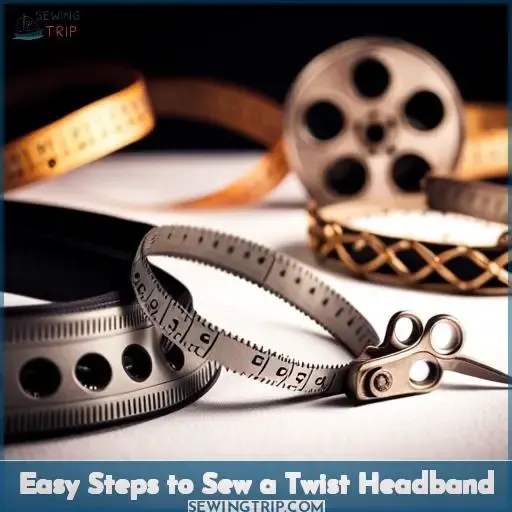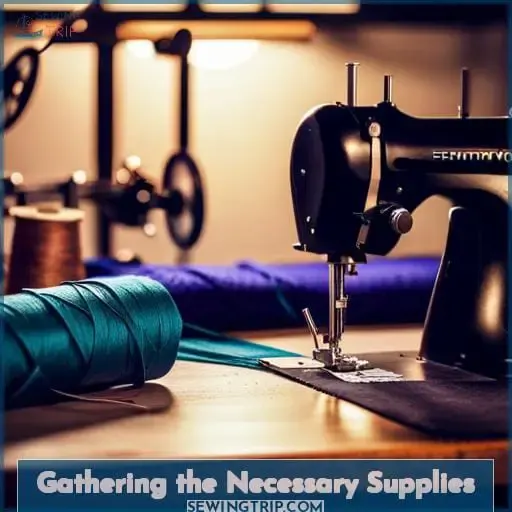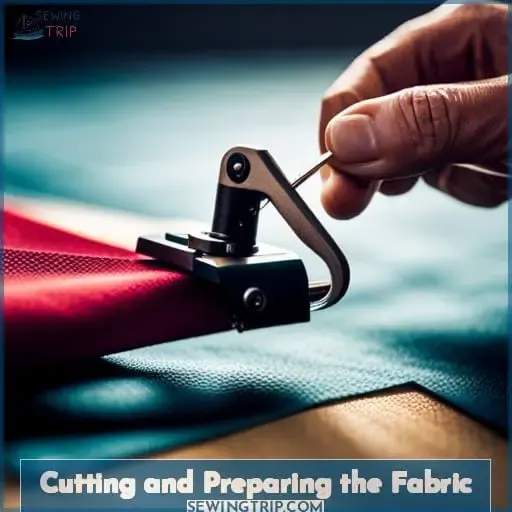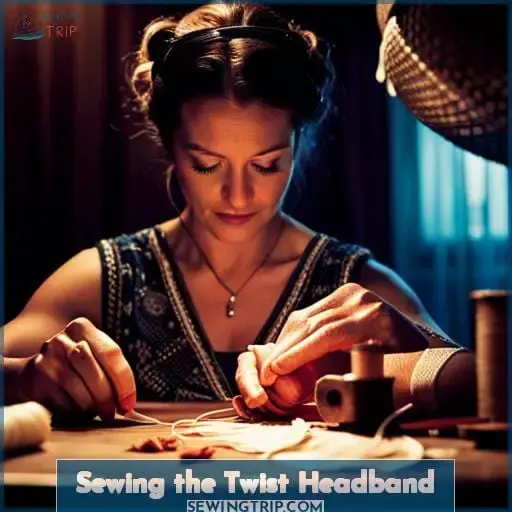This site is supported by our readers. We may earn a commission, at no cost to you, if you purchase through links.
 Imagine being able to create your own stylish twist headbands with just a few simple steps. With this easy-to-follow tutorial, you’ll learn how to sew a twist headband that will elevate your accessory game and showcase your unique style.
Imagine being able to create your own stylish twist headbands with just a few simple steps. With this easy-to-follow tutorial, you’ll learn how to sew a twist headband that will elevate your accessory game and showcase your unique style.
Whether you’re an experienced sewer or just starting out, these step-by-step instructions will guide you through the process effortlessly.
Get ready to unleash your creativity and master the art of sewing beautiful twist headbands that are sure to turn heads wherever you go!
Table Of Contents
Key Takeaways
- Knit fabric with good stretch and recovery is ideal for making a twist headband.
- Cotton spandex jersey, double brushed poly, and French terry with spandex are suitable fabric options.
- Cut the fabric along the grain line and leave a seam allowance around each edge.
- Pin the fabric together with right sides together, sew with a 1/2-inch seam allowance, and turn the headband right side out.
Choosing the Right Fabric for a Twist Headband
When choosing the right fabric for a twist headband, there are a few factors to consider.
Firstly, it’s important to select a knit fabric with good stretch and recovery. This will ensure that the headband fits comfortably and holds its shape well.
Additionally, you may want to choose fabrics such as cotton spandex jersey or double brushed poly which are soft against the skin and provide ample stretch for easy twisting and styling of the headband.
Types of Fabric Suitable for a Twist Headband
When sewing a twist headband, it’s important to choose the right fabric for optimal stretch and recovery.
- Knit fabric with good stretch and recovery: This type of fabric is perfect for creating a comfortable and snug fit.
- Cotton spandex jersey: It offers both breathability and flexibility, making it an ideal choice for active individuals.
- Double brushed poly: This lightweight fabric provides excellent drape and softness while still maintaining durability.
- French terry with spandex in the blend: It combines comfort, breathability, and versatility all in one package.
Choose any of these fabrics to create stylish twist headbands that are easy to care for as they’re machine washable!
Factors to Consider When Selecting Fabric
To choose the right fabric for a twist headband, consider factors such as stretch and recovery, comfort against the skin, and personal preference.
When selecting fabric for your headband project, it’s important to choose a material that has enough stretch to comfortably fit around your head while also providing stability. Additionally, think about the drape of the fabric and how it will lay when twisted.
Lastly,color choice is crucial in order to create a stylish accessory that complements your outfit perfectly.
| Factors | Considerations |
|---|---|
| Stretch | Ensure there’s enough elasticity in the fabric for easy fitting |
| Drape | Choose a material with good draping properties |
| Weight | Opt for lightweight fabrics that won’t feel heavy on your head |
When selecting fabric for sewing a twist headband, there are several factors you should consider to ensure optimal results.
- First and foremost, is determining if the chosen fabris stretchy enough as this will allowthe bandto comfortably fit around different sizes of heads.
- The next factoris considering how wellthe fabriconformsto one’s preferencesin terms of colorand design.
- Additionally,the drapeofthefabricshould be taken into accountasit affectshow thematerialwilllaywhentwisted.
- To achievea harmonious balance betweencomfortand style,it’simportantto selectfabricswith an appropriate weightthat won’tfeeltooheavyonyourhead.
- Finally,stabilityofthefabricduringuseismustbeconsideredtosurethatyourtwistheadbandsremainsecurelyin place throughoutthewearingsession.
By keeping these factors in mindwhen choosingfabricforatwistheadbandproject,youcancreateaccessoriesthatnotonlylookgreatbutalso provide maximum comfortagainsttheskin.Whether youpreferstretchycottonspandex,jerseydoublebrushedpoly,orFrenchterrywithaspandexblend,thechoiceofmaterialisinherentlypersonalandshouldreflectyouruniquestyleandsensibilities.
Gathering the Necessary Supplies
To sew a twist headband, you’ll need a few essential supplies.
- 1/4 yard of knit fabric
- Coordinating thread
- A sewing machine or serger
You can find these supplies at your local fabric store or online retailers that specialize in sewing materials.
Gathering the necessary supplies is the first step towards creating your own stylish and comfortable twist headband.
List of Supplies Needed for Sewing a Twist Headband
To gather the necessary supplies for sewing a twist headband, you’ll need specific materials and tools.
Fabric of your desired width and length
A sewing machine or serger to stitch the fabric together
Thread that matches the fabric color
Pins to hold everything in place while sewing
A needle for hand-sewing if needed
Don’t forget about seam allowance when cutting your fabric!
These supplies are essential for creating your own stylish twist headbands.
Where to Purchase the Supplies
You can purchase the necessary supplies for sewing a twist headband at various fabric stores or online retailers.
- Online Stores: Websites like Amazon offer a wide selection of fabrics, threads, and other sewing notions.
- Fabric Stores: Visit your local fabric store to browse through their collection of knit fabrics and grab all the essentials.
- Craft Stores: Explore craft stores that carry sewing supplies to find unique patterns and materials for your twist headbands.
Cutting and Preparing the Fabric
To begin sewing a twist headband, you need to determine the dimensions based on the size you want.
For example, for an adult-sized headband, cut a rectangle that’s 9 inches tall and 19-21 inches wide.
Once you have your measurements, it’s time to cut and prepare the fabric.
Use sharp scissors or a rotary cutter to ensure clean cuts, and make sure your fabric has good stretch and recovery for comfort when wearing.
Determining the Dimensions for the Headband Based on Size
First, determine the dimensions of your twist headband based on the desired size.
To help you with this, refer to the following table:
| Size | Width (inches) | Length (inches) |
|---|---|---|
| 0-6 months | 6 | 14 |
| 6-12 months | 6 | 15 |
| Toddler | 7 16 |
Tips for Cutting and Preparing the Fabric
Once you have determined the dimensions for your twist headband based on size, it’s time to move on to cutting and preparing the fabric.
When cutting your fabric, make sure to pay attention to the grain direction and stretch of the fabric. It’s important that you cut along the grain line so that your headband will drape nicely when worn.
Additionally, consider leaving a seam allowance around each edge for sewing purposes.
Lastly, if using a lining fabric, be sure to cut it in the same dimensions as your main fabric piece.
Sewing the Twist Headband
Now that you have cut and prepared the fabric, it’s time to sew the twist headband. This step-by-step process will guide you through sewing techniques and stitches to use in order to achieve a professional-looking result.
By following these instructions, you’ll be able to create a stylish and functional twist headband with ease.
-
Pin the fabric together. With right sides together, pin the two fabric pieces together along the long edge.
-
Sew the fabric together. Using a 1/2-inch seam allowance, sew the fabric together along the long edge.
-
Turn the headband right side out. Carefully turn the headband right side out, using a point turner or other blunt object to help push out the corners.
-
Press the headband. Press the headband flat, making sure to press the seam allowances open.
-
Topstitch the headband. Using a contrasting thread, topstitch the headband along the long edge.
-
Add the elastic. Cut a piece of elastic that is 1 inch longer than the circumference of your head.
-
Pin the elastic to the headband. With right sides together, pin the elastic to the headband, 1/2 inch from the edge.
-
Sew the elastic to the headband. Using a 1/2-inch seam allowance, sew the elastic to the headband.
-
Turn the headband right side out. Carefully turn the headband right side out, using a point turner or other blunt object to help push out the corners.
-
Press the headband. Press the headband flat, making sure to press the seam allowances open.
-
Enjoy your new twist headband!
Step-by-step Instructions for Sewing the Headband
To sew the twist headband, start by aligning the folded fabric with right sides together.
Sew along the long edge using a zigzag stitch or serger.
Turn it right side out and fold it in half with the short ends matching up.
Offset one end so that the center seam of one half lines up with the edge of the other half.
Fold one layer under and bring another layer on top to create a twist effect.
Sew all layers together, adjusting size and width as desired for your perfect headband.
Sewing Techniques and Stitches to Use
To sew the twist headband, you’ll need to use specific sewing techniques and stitches.
- Zigzag stitch: Ideal for securing seams on stretchy fabrics like knit.
- Straight stitch: Used for basic stitching and joining fabric pieces together.
- French seam: A clean finish that encloses raw edges within the seam itself.
Finishing and Styling the Headband
Now that you have successfully sewn your twist headband, it’s time to give it a polished finish.
Start by trimming any excess threads and fabric to ensure a clean look.
Then, explore the different ways you can wear and style your new headband – whether it’s twisted on top or worn as an accent piece at the back of your hair, there are plenty of options to suit your personal taste and style.
Get creative with how you showcase this trendy accessory!
Trimming Excess Threads and Fabric
Now, you can trim any excess threads and fabric from your twist headband to give it a clean and polished finish.
To achieve a neat and professional look, use pinking shears to trim the raw edges of the fabric.
Snip any loose threads close to the surface of the headband for a tidy appearance.
Take care in trimming away any excess fabric while maintaining an even edge for a sleek finish.
| Tips for Trimming Excess Threads and Fabric | Benefits |
|---|---|
| Use pinking shears | Avoids bulky seams |
| Snip threads close | Prevents fraying |
Different Ways to Wear and Style the Twist Headband
There are multiple ways you can wear and style your twist headband to complement various outfits and occasions.
Try a front tuck or back tuck for a chic look, or tie a front knot or back knot for added flair.
For an effortless style, go for the half up, half down hairstyle with the twist headband.
You can also pair it with a side braid or side ponytail for some extra charm.
And don’t forget about the classic low bun or high bun paired with the twist headband to complete any elegant ensemble!
Troubleshooting and Tips for Success
Now that you have learned the easy steps to sew a twist headband, let’s address some common issues you may encounter during the sewing process.
From fabric choices to stitching techniques, I’ll provide troubleshooting tips and tricks to help you achieve a polished finished product. Additionally, I’ll share some additional pointers for success that I’ve gathered through my extensive expertise in teaching students how to sew.
Common Issues Encountered During Sewing and How to Fix Them
If you encounter any common issues while sewing the twist headband, here are some tips to help you troubleshoot and fix them:
- To address tension problems, adjust the tension settings on your sewing machine or serger until the stitches look even and balanced.
- If you notice unraveling fabric, reinforce your seams with backstitching or use a fabric glue to secure loose threads.
- Crooked stitching can be fixed by practicing good hand-eye coordination and guiding the fabric carefully through the machine.
- For knotted threads, check for thread snags or tangles in your machine’s bobbin area before rethreading it properly.
Additional Tips and Tricks for Achieving a Polished Finished Product
To ensure a polished finished product, troubleshoot any issues and implement these helpful tips and tricks while sewing your twist headband.
Use fusible interfacing to add stability and structure to the fabric.
Press seams open for a cleaner look.
If you make a mistake, don’t hesitate to use a seam ripper to undo stitches and start again.
Finish raw edges with techniques like zigzag stitching or serging for durability.
Remember these tips for success!
Frequently Asked Questions (FAQs)
Can I use a non-stretch fabric for the twist headband?
Yes, you can use a non-stretch fabric for the twist headband.
However, using a knit fabric with good stretch and recovery will provide better comfort and fit.
Consider the desired look and feel before making your choice.
Can I adjust the size of the twist headband to fit a child or adult?
Yes, you can easily adjust the size of the twist headband to fit a child or adult.
Simply cut a rectangle of fabric in the desired dimensions and follow the assembly instructions accordingly.
How do I determine the width of the twist headband?
To determine the width of your twist headband, consider the age or size of the intended wearer.
For children, use a narrower width like 6-8 inches.
Adults may prefer a wider band measuring 9-10 inches for optimal comfort and style.
Can I use a different type of stitch instead of a zigzag stitch for sewing the twist headband?
Yes, you have the power to use a different stitch for the twist headband. However, remember that the zigzag stitch provides durability and flexibility to accommodate stretchy fabric.
Are there any styling options or variations for the twist headband?
To add a personal touch to your twist headband, experiment with different fabric prints and textures.
You can also try embellishments like bows or flowers for added flair.
Get creative and make it uniquely yours!
Conclusion
In your quest for the perfect twist headband, you’ve discovered the ultimate guide to sewing your own stylish accessory. With a touch of irony, this tutorial has equipped you with the knowledge and skills of a seasoned sewing instructor.
From selecting the right fabric to mastering the sewing techniques, you’re now ready to create headbands that showcase your unique style.
So, get your supplies ready and let your creativity soar as you sew your way to headband perfection!












